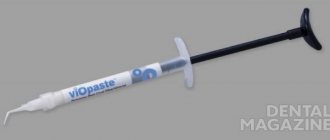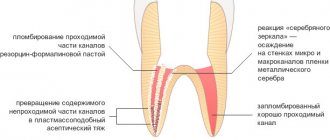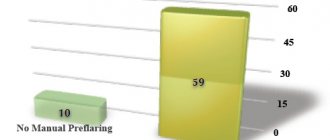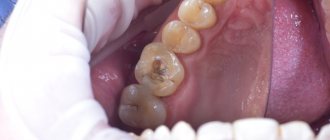- When is root canal filling indicated?
- What are the purposes of temporary filling?
- What material should be used for temporary filling?
- How does filling occur?
- What does pain after filling mean?
- Types of fillings
- Types of pastes
- How much does temporary root canal filling cost?
The period for which a temporary filling is placed is determined by the attending physician.
In most cases, a drug that has a long shelf life is placed under the filling material. After this period, the doctor removes the temporary material. When medicinal pastes are used together with disinfectants and antiseptic medications, there is a significant increase in the effectiveness of treatment. In addition, there will be no cross-contamination of soft and hard tissues between visits to the doctor.
When is root canal filling indicated?
There are general indications for the procedure:
- The root canal is affected. This happens if the patient has a chronic form of pulpitis.
- During the purulent stage of pulpitis, regardless of whether the tooth cavity is closed/open.
- If intraradicular soft tissues are excessively affected.
After mechanical processing is completed, a funnel-shaped channel is formed. It has a minimum diameter at the apex, and a minimum at the mouth. Also, the balance between the “diameter and wall thickness” of the channel is observed.
Filling root canals with cold gutta-percha
Single pin method
This method consists in the fact that after appropriate treatment of the canal, which means giving it a taper of 4, 6 or 8%, a sealer is applied to its walls using a paper point. After this, a pre-selected pin with an appropriate taper and tip size is inserted into the canal. The pin should fit snugly against the canal walls. Some authors recommend shortening the tip of the pin by 0.5 mm. Using a heated tool, the pin is cut at the level of the mouth and its condensation is carried out in the vertical direction.
This technique can be a good alternative for doctors who prefer to fill canals with monopaste, but this only ensures filling the lumen of the main canal, and not three-dimensional obturation of the entire root canal system.
What material should be used for temporary filling?
There are special requirements for the material used for filling:
- Creating complete tightness, which is achieved by penetrating even the smallest cracks. This helps create a kind of barrier that prevents the development of bacteria. If microorganisms develop a small cavity into which they can penetrate, the inflammatory process will re-develop.
- The materials should be clearly visible on x-ray. Thanks to this, the doctor is convinced that high-quality work has been done.
- High aesthetics. The material should not be visible through tooth enamel.
- Saliva, hard or soft tissues of the oral cavity should not provoke an allergic reaction by contacting the filling mass.
- Materials for temporary filling of root canals should be easily removed from the roots. After the substance hardens, a slight shrinkage effect may appear, but no cavities are formed.
How does filling occur?
Before temporary filling of the canals begins, the patient is sent for an X-ray examination. Using the image, the extent and depth of the lesion is determined. Then a technique is selected and the procedure begins. It consists of the following steps:
1. Administration of anesthesia. Local anesthesia is used. Many patients have a fear of the sound of the drill, even if there is no pain. These patients are given intravenous sedation.
2. Clean the tissues affected by caries (enamel, dentin).
3. The dental nerve is removed.
4. Probe the root passage. Its depth is determined.
5. The width of the passage is expanded and drilled.
6. Wash with an antiseptic solution and dry.
7. If necessary, a pin is inserted.
8. Material is placed into the cavity, taking into account the developed technique.
9. Carrying out a control x-ray examination.
What does pain after filling mean?
The presence of discomfort for three to five days after the procedure is normal. The reason for their appearance is irritated gum tissue and pulp. The patient may complain of a feeling of fullness inside the treated tooth. This is also normal.
To avoid negative consequences, you should contact only an experienced and qualified specialist. Otherwise, the following consequences may arise due to mistakes made:
- A through hole is formed in the root canal.
- Secondary inflammation develops under the filling material.
- Flux and fistula develop.
- A cyst or granuloma forms.
- Allergic reaction to the material.
By choosing a clinic that has a good reputation, you can not be afraid of the above problems.
Types of fillings
There are 2 types - temporary and permanent root canal filling.
The first method uses a non-hardening paste, which is distinguished by the presence of medicinal properties. Getting a good result occurs due to calcium hydroxide. The use of temporary filling is indicated for advanced pulpitis, when the inflammatory process has spread quite deeply. A special material is placed into the cavity and covered with a filling. Installation of a permanent filling may take several days or even months.
The second method (permanent filling) is carried out for more than a dozen years. The procedure is allowed immediately during the first visit to the doctor, if there is no inflammatory process, or after treatment with temporary material has ended.
Vertical condensation
This very labor-intensive method of filling root canals is based on the use of hot (heated) gutta-percha. First, the apical part of the root canal is filled with heated and largely softened or almost liquid gutta-percha, and then compacted by machine (condensed).
This part of the vertically condensed gutta-percha root filling is called Downpack according to the English terminology currently used in Germany.
For compaction, heated instruments are used to keep the gutta-percha in a softened state until it is completely compacted. To condense gutta-percha, among many other systems, rotating instruments are used, which, due to the release of heat during friction, help to soften part of the Downpack root filling.
The part of a root filling made of vertically condensed gutta-percha is called a Downpack according to the English terminology currently used in Germany. The root canal filling technique, first described by Schilder in 1967, is very labor-intensive because it requires special devices for heating and condensing gutta-percha. In addition, tapered Master Points are required, which must exactly match the taper and volume of the root canal or the last instrument used to develop the root canal. Then, before inserting into the root canal, the gutta-percha pins are shortened at the apex by 0.5-1 mm so that if there is significant compaction (condensation) in the canal, the material is not removed beyond the apical opening.
In addition, according to the Schilder technique, the Master Point is first fitted into the root canal, after which a control radiograph is taken, which verifies the correct seating of the pin in the canal. Only after this is its final condensation in the root canal.
After filling the apical third, the middle and upper parts of the root canal (Backfill) are also filled with heated gutta-percha, which is injected directly into the canal using a syringe. To do this, gutta-percha is preheated in a special device (oven) to a liquid state. This labor-intensive method results in root fillings that adhere very well to the walls of the root canal.
Due to their almost perfect tightness, such seals effectively prevent the penetration of bacteria into it.
This is what the technique of vertical condensation of gutta-percha looks like in general. However, there are various modifications of Schilder's original method. Some dentists create a new “ideology” from every new little thing they come up with and do not allow the slightest deviation from “their” concept. The choice of one or another method of canal filling depends to a certain extent on the beliefs of the dentist.
Dental manufacturing companies have been very successful in making money from endless variations of the vertical condensation method, selling pluggers and ovens for preheating gutta-percha, as well as “special gutta-percha.”
Types of pastes
Paste containing an antibiotic and a corticosteroid
In most cases, such a paste contains 2-3 broad-spectrum antibacterial drugs and a corticosteroid. Basically, it is dexamethasone. The paste contains it in a certain amount, therefore, while reducing inflammation and allergic reactions, there is no disruption of the periodontal protective reactions. The third component is a radiopaque filler. Thanks to him, it is possible to objectively assess how well the channels have been filled. This paste has a strong, but not long-lasting effect. The duration of their presence in the dental canals varies from three to seven days.
Paste containing metronidazole
This component helps to effectively suppress pathogenic microflora in the root canals, stop kagabolic tissue destruction, and block the inflammation process. The patient will not have an allergic reaction to such a paste, and there is also no need to be afraid of addiction.
A paste with this component is used in case of excessive infection of the canals. In addition, such a remedy can cure the acute stage of periodontitis. As a result, re-infection can be easily prevented. Also, the disease progresses much easier.
Paste based on a long-lasting antiseptic mixture
This type of paste consists of antiseptic components that have a strong effect - camphor, thymol, cresol, menthol, etc. This is a radiopaque paste, it does not harden, and gradually dissolves in the root canal. Indications for the use of such a paste are the presence of pulpitis, periodontitis, and problems with baby teeth.
Calcium hydroxide paste
A highly alkaline reaction occurs; when the canal is filled with this substance, various bacteria are destroyed and necrotic tissue is destroyed. In addition, stimulation of ostogenesis, dentinogenesis and cementogenesis begins.
The use of a non-hardening paste, which includes calcium hydroxide, is necessary for severe periodontitis, cystogranuloma. This mass is placed in the channel; a special channel filler is used for this purpose.
After six weeks, the paste is replaced. A new portion is placed into the root canals. After this, the paste is changed every eight weeks until the desired result is achieved. If the pain and inflammation have disappeared, and exudation has stopped, the doctor cleans the canals and fills them with permanent filling material.
Temporary obturation of root canals
In 90% of cases, infection is the main cause of periodontitis. In some cases, during the treatment of periodontitis, pain and swelling of the soft tissues persist even after intracanal treatment using potent agents.
Changes in the microbial flora or disturbances in its balance lead to clinical exacerbation of periodontitis. Foci of chronic infection in the area of the apex of the tooth root adversely affect the immunological status of the body. At the same time, during a purulent-inflammatory process in the pulp and periodontal tissues, the infection penetrates through the dentinal tubules into the thickness of the root dentin.
Therefore, along with generally accepted technologies for root canal treatment, it is necessary to carry out temporary root obturation in order to have a prolonged antiseptic effect on the root canal system. It should be said that the most thorough medicinal treatment of the canal does not guarantee against its reinfection.
Preparations based on calcium hydroxide, which have been known in dentistry since 1920, have gained widespread acceptance as a means for temporary filling of root canals, but have gained recognition in endodontics only in the last two decades.
Calcium hydroxide is characterized by the following properties:
- antiseptic effect;
- anti-inflammatory properties;
- high chemical activity,
- having a highly alkaline reaction (pH = 12.5);
- stimulation of reparative processes in the apical periodontium due to increased activity of osteoblasts;
- hemostatic effect.
The antiseptic effect of a paste based on calcium hydroxide lasts for 2–3 weeks, until its pH drops below 8. It is believed that this time is sufficient for complete disinfection of the root canal. This is a period of short treatment for teeth with pulp necrosis, after which permanent root canal filling is performed.
Sandquist (1992) found that after the introduction of phenol-containing drugs into a temporary dressing, it was possible to completely free the canal from bacteria in 66% of cases, and after using calcium hydroxide, this effect was achieved in 97% of cases.
For use in endodontic practice, calcium hydroxide preparations are available in the form of liquid, powder, and ready-to-use pastes. When using preparations containing calcium hydroxide, one should take into account its high chemical activity, since when interacting with carbon dioxide in the air, inactivation of Ca(OH)2 occurs. In this regard, manufacturers to one degree or another protect preparations with calcium hydroxide from air contact.
The use of non-hardening pastes based on calcium hydroxide is indicated as a temporary intracanal agent:
- in acute forms of apical periodontitis;
- destructive forms of chronic apical periodontitis;
- cystogranulomas and radicular cysts;
- progressive root resorption;
- treatment of teeth with unformed root apex in pediatric practice.
For different conditions of the apical periodontium, the technique of temporary filling of root canals with calcium hydroxide is different. This is due to the different goals that are set at different stages of treatment. In acute forms of apical periodontitis, calcium hydroxide is introduced into the root canal loosely, without compaction, for 1–3–7 days, depending on the clinical picture.
The main purpose of temporary filling is anti-inflammatory and antimicrobial effect.
In case of chronic destructive processes in the apical periodontium, calcium hydroxide is injected into the root canal with compaction to the walls for 1.5–2 months, the material is renewed depending on the clinical situation until the desired result is achieved. The duration of dental treatment is calculated for a period of 0.5 to 1 year and depends on the degree of infection of the root canal, the body’s resistance, the patient’s age, and motivation for treatment.
The main purpose of temporary filling is to stimulate regeneration processes.
The following scheme for using pastes with calcium hydroxide to restore the periapical lesion is proposed:
- The paste is injected into the prepared canal for 7–10 days under an airtight bandage;
- on the next visit, the canal is cleared of paste, washed with sodium hypochlorite solution and filled with a new portion of paste for 1 month;
- subsequent visits are carried out after 3 months, the same manipulations are performed
It is recommended to take the first control x-ray to assess the effectiveness of treatment no earlier than after 3 months. after the first visit.
Restoration of the zone of destruction of the apical periodontium then continues for 3–5 years after permanent filling of the root canal with a sealer based on calcium hydroxide.
Currently, manufacturers modify preparations based on calcium hydroxide by introducing additional antiseptic additives into their composition, potentiating the antimicrobial effect of temporary filling. Both domestic and foreign manufacturers introduce iodoform into pastes based on calcium hydroxide, bringing its content to 40%.
Omega Dent produces two preparations based on calcium hydroxide for temporary filling of canals for periodontitis. These are “Calcept” and “Calcept with iodoform”.
“Calcept” contains sterile calcium hydroxide, and “Calcept with iodoform” contains calcium hydroxide and iodoform, which significantly enhances the bactericidal properties of the drug. The drugs are supplied in syringes and equipped with convenient cannulas for administering the drug directly into the mouth of the root canal.









